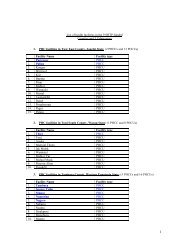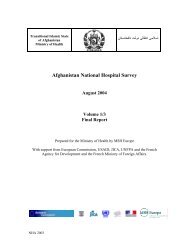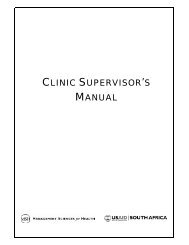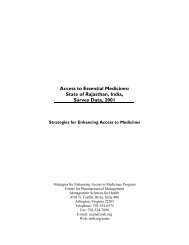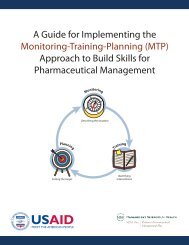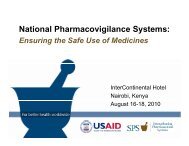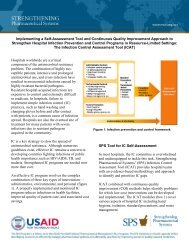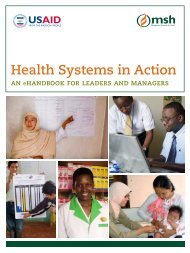Evaluation of Malawi's Emergency Human Resources Programme
Evaluation of Malawi's Emergency Human Resources Programme
Evaluation of Malawi's Emergency Human Resources Programme
You also want an ePaper? Increase the reach of your titles
YUMPU automatically turns print PDFs into web optimized ePapers that Google loves.
Management Sciences for Health<br />
Based on analysis <strong>of</strong> the data, the evaluation team has documented results and lessons<br />
learnt from the <strong>Programme</strong>, and made evidence-based recommendations for strengthening<br />
<strong>Human</strong> <strong>Resources</strong> for Health (HRH) systems and practices in Malawi’s public health<br />
sector.<br />
TECHNICAL APPROACH AND METHODOLOGY<br />
In order to address the project objectives in the most comprehensive, cohesive and<br />
consistent manner, the consultants adopted a multi-pronged consultative and clientfocused<br />
process that was led by an EHRP <strong>Human</strong> Resource Task Force and chaired by the<br />
Ministry <strong>of</strong> Health with representatives from various units in the health sector.<br />
The evaluation included a combination <strong>of</strong> traditional research methods and other field<br />
tested approaches to gather data. A variety <strong>of</strong> tools were employed during the data<br />
gathering process. For quantitative data, primary source data was gathered from the MOH<br />
and pre-service training institutions, reports and desk reviews. Qualitative data was<br />
collected through focus group discussions and key informant interviews using a set <strong>of</strong> well<br />
structured research questions derived from an <strong>Evaluation</strong> Framework designed by the<br />
consultants. Additional qualitative data was gathered through an HRM survey <strong>of</strong> district<br />
level managers, each <strong>of</strong> whom reportedly had significant responsibilities for HRM in<br />
MoH, to identify competency gaps in HRM. Analysis <strong>of</strong> the data was conducted in<br />
collaboration with the HR Taskforce.<br />
KEY FINDINGS, COST AND IMPACT<br />
Overall, the findings <strong>of</strong> this evaluation indicate that the EHRP successfully accomplished<br />
its primary goal <strong>of</strong> increasing the number <strong>of</strong> pr<strong>of</strong>essional health workers in Ministry <strong>of</strong><br />
Health and CHAM institutions. Across the 11 priority cadres, the total number <strong>of</strong><br />
pr<strong>of</strong>essional health workers increased by 53%, from 5,453 in 2004 to 8,369 in 2009.<br />
However, only 4 <strong>of</strong> the 11 cadres met or exceeded their targets, as set out in the original<br />
EHRP design document. A hardship incentive package that was included as part <strong>of</strong> the<br />
financial incentives was not implemented.<br />
Total graduates from Malawi’s four main training institutions – the Christian Health<br />
Association <strong>of</strong> Malawi, Malawi College <strong>of</strong> Health Sciences, Kamuzu College <strong>of</strong> Nursing,<br />
and the College <strong>of</strong> Medicine – showed an overall increase <strong>of</strong> 39%, from 917 in 2004 to<br />
1,277 in 2009. Physicians from the College <strong>of</strong> Medicine increased by 72%, from 18<br />
graduates in 2004 to 31 graduates in 2009. Nurses increased by 22%, from 575 graduates<br />
in 2004 to 699 graduates in 2009.<br />
A summary <strong>of</strong> all components <strong>of</strong> the EHRP is outlined on the following page.<br />
EHRP <strong>Evaluation</strong> Final Report Page 2



